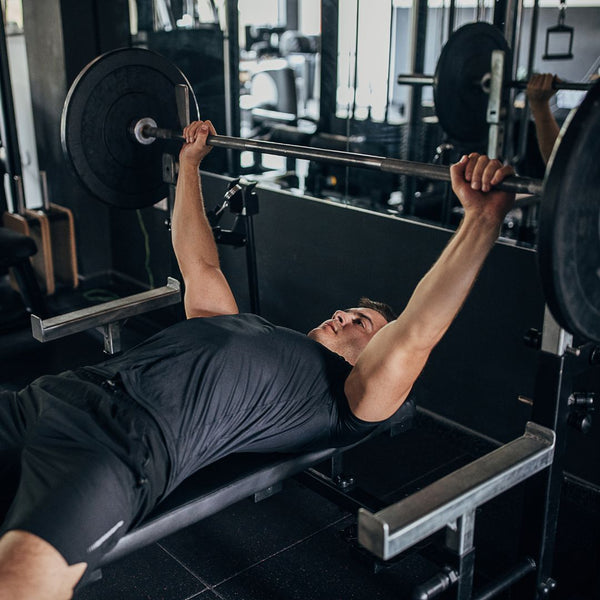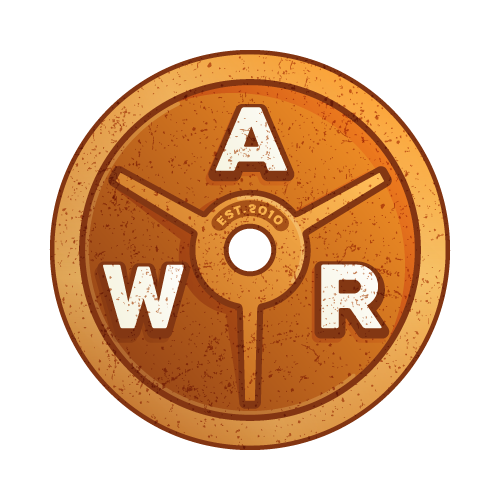Has your chest training stalled? Are you not getting the results you want? One possible reason is you’re not doing enough work in the gym. Or maybe you’re doing too much!
Optimizing your muscle growth relies on finding the perfect balance of work and rest, and it’s time you stop guessing what you should be doing.
We’ll tell you how many chest exercises per workout you should be doing and how many sets of each. If you’ve been playing the guessing game in the gym on chest day, read this article to make the most of your time in the gym and start putting mass on your chest.
More Or Less Exercises For Muscle Growth?
Knowing the best number of chest exercises to use is essential for performing the proper amount of work.
Spend any amount of time online, and you’ll see a wide variety of suggestions. Some minimalists say one set is enough, while maximalists seem to perform dozens of exercises every training session.
What makes this even more confusing is that they both seem to work.
It’s not hard to find guys who use just 1-2 chest exercises every week and see good results. On the other hand, the guys doing three variations of bench press and five variations of chest flys, pushups, dips, and pec-dec in a single session may also get some good results.
Therefore, we’re looking for the number that will optimize your training.
So, how many chest exercises per week do you need to get the best results without wasting time and energy?
The TLDR for how many chest exercises per workout to get the best results:
- 3-4 exercises per session
- Maximum of 20 working sets weekly
- Two sessions weekly
We’ll breakdown all you need to know regarding the science behind that recommendation.
Let’s get into the details below.
Optimizing Your Chest Training
Getting the results from your chest training relies on you altering the correct variables to maximize progressive overload for both hypertrophy and strength.
Although seemingly simple, determining how much stimulus to provide the muscle and how much rest it should have has been made more complicated than needed.
We’ll fix that.
You need only decide on the perfect volume of training and the number of times you’ll train weekly. Ultimately, these two factors will determine how many chest exercises you should use per workout.
The Perfect Training Volume For Your Chest
Researchers still haven’t nailed down the exact mechanisms for muscle growth. However, one training variable consistently stands out as a primary driver: training volume.
Training volume is the amount of work placed on the muscle, which is the primary driver of muscle growth. Training volume can be added up in two ways.
- Adding up the total weight lifted determined by the formula: Volume= Sets x Reps x Load
- Adding up the total amount of working sets.
Generally speaking, it’s easiest just to use working sets, assuming those sets are worked to near failure.
That said, numerous studies have shown a dose-response for volume and muscle growth, which means that when more volume is placed on a muscle, it grows more.¹
For example, growth can be seen using just 1 or 2 weekly sets. However, performing 6 sets is better, and doing 10 sets is better than 6.
This trend is true, but only until a certain point.
While more can be better at first, you will hit a point that makes it difficult for your muscles to recover. At this point, you’ll start seeing diminished returns. If you keep doing more, you could even see a drop in growth.
Think about grilling a steak. You would grill one side for a little bit and then flip it. Let the other side cook for a bit, and then flip it. This prevents the meat from getting too much heat at once and prevents it from burning.
Now imagine if you threw some steak on a grill, threw the lid on, and just left. What would happen? It would burn!
This is similar to the concept of training volume. Too much training will result in irreparable damage.
This makes it important to ensure enough training but not too much.
As the number can vary depending on the muscle group and the specific lifter, you should aim to train your chest with at least 10 working sets weekly. On the upper end, you should limit your training to 20 working sets. ¹
The Ideal Training Frequency For Your Chest
We saw above that the maximum number of weekly sets you can train your chest is 20. So, should you train all 20 sets in one day or break it up?
This is your training frequency—how often you train your chest weekly.
Just as your chest can only see optimal recovery from a total set of weekly sets, the same is true concerning the total sets during a single session.
While total volume is the ultimate goal, the truth is that if you were to perform all of your sets in one day, your muscles would fatigue after a while. Once this occurs, you would simply be performing junk volume.
Even if it weren’t junk volume, you wouldn’t have the energy to maintain high-performance levels. This would ultimately result in training at a lower intensity and less overall volume.
For example, let’s go with the max of 20 sets. Here’s how that might look in a single session:
- Bench Press: 4 Sets
- Incline Bench Press: 4 Sets
- Dips: 3 Sets
- Incline Fly: 3 Sets
- Decline Fly: 3 Sets
- Close Grip Pushups: 3 Sets
There’s simply no way you would be training at optimal intensity the whole way through. You’d just be going through the motions.
For this reason, research suggests that splitting your total working volume into two sessions provides the best stimulus for muscle growth.²
This allows you to train with the highest intensity while maximizing the rest your chest gets.
Train hard. Go home and rest.
Train hard. Go home and rest.
Repeat this cycle weekly.
A 2019 study showed this where researchers had two groups of lifters. Each group trained each muscle group with 16 weekly sets. However, one group performed all 16 sets for a muscle group in a single session, while the other group trained a muscle group with 8 sets twice weekly.³
The group that trained a muscle group twice weekly saw slightly greater improvement. While the results weren’t significant, it’s important to remember that the study was only done for 8 weeks. It’s also likely to be of greater significance with the more sets you perform.
Further, we are speaking about optimizing results.
So, How Many Chest Exercises Per Workout Should You Do?
So now that you have your training frequency and volume figured out, we can set the perfect number of exercises. Well, one other variable may make a slight difference: whether you’re training for strength or hypertrophy.
Training for strength and muscle hypertrophy looks slightly different as your goals differ and occur through different physiological processes. Therefore, the number of chest exercises you use per workout may differ slightly.
How Many Chest Exercises Per Workout For Muscle Growth
Training the chest for muscle growth will be centered around increasing training volume and exercise variation.
Research has shown that muscle growth is not seen uniformly from a single exercise.?
Rather, the part of the muscle that experiences the most stress will see more growth. For example:
- The lower part of the bicep during preacher curls
- The upper chest during incline bench press
- The lower quadricep during leg extensions.
Therefore, to see fuller growth of a muscle, you should hit it from different angles and use different movement patterns. Studies have shown that a muscle sees fuller growth when trained with three exercises compared to one.
To be clear, these different exercises should use different movement patterns. For example, performing a barbell bench press, dumbbell bench press, and pushups would be redundant as they use similar movement patterns.
Therefore, to optimize muscle hypertrophy, 4 exercises per workout would be on the upper end of the body. This allows for primary exercise, 1-2 assistance exercises, and 1-2 isolations—a total of 10 sets.
For example:
- Bench Press: 3 Sets
- Incline Dumbbell Press: 3 Sets
- Cable Fly: 2 Sets
- Dumbbell Pullover: 2 Sets
And don’t worry. Two sets with maximal intensity are plenty to induce muscle hypertrophy.
How Many Chest Exercises Per Workout For Strength?
If strength is your primary goal, you could do well with just three exercises. Generally speaking, the primary exercise during the strength session will be performed with more sets (4 or 5 sets).
Further, using multiple small exercises is less common, resulting in a slightly smaller number of chest exercises you should use.
Therefore, using 3 exercises to train your chest allows plenty of sets for your primary exercise, followed by 2 secondary or assistance exercises. For example:
- Bench Press: 4 Sets
- Incline Bench Press: 3 Sets
- Dips: 3 Sets
Again, this would be on the assumption you’re training 20 sets a week.
How Many Chest Exercises Per Workout? Final Guidelines
To optimize your chest training for maximal growth gains, aim to train it twice per week with a maximum number of 20 working sets. This should then be done with no more than 3-4 exercises per session.
Now, this is simply a guideline.
If your split doesn’t allow this many exercises, you’ll just perform however many you can. For example, you may perform a full-body split and train the chest 3 times a week. In this case, you’ll likely just be able to train one or two chest exercises per session.
Still, the total number of sets is the ultimate determining factor in how many exercises you use.
When considering everything, if you train with the proper intensity, these 3 or 4 exercises should bring you to a high state of fatigue, and you shouldn’t want to do more. If you want to do more, you’re likely not training hard enough.
Train harder, not more.
Now you know how many exercises to do next up is to find out How Long You Should Rest Between Sets?
References
- Schoenfeld, Brad J, et al. “Dose-Response Relationship between Weekly Resistance Training Volume and Increases in Muscle Mass: A Systematic Review and Meta-Analysis.” Journal of Sports Sciences, vol. 35, no. 11, 2017, pp. 1073–1082, www.ncbi.nlm.nih.gov/pubmed/27433992, https://doi.org/10.1080/02640414.2016.1210197.
- Schoenfeld, Brad J., et al. “Effects of Resistance Training Frequency on Measures of Muscle Hypertrophy: A Systematic Review and Meta-Analysis.” Sports Medicine, vol. 46, no. 11, 21 Apr. 2016, pp. 1689–1697, https://doi.org/10.1007/s40279-016-0543-8.
- Brigatto, Felipe A., et al. “Effect of Resistance Training Frequency on Neuromuscular Performance and Muscle Morphology after 8 Weeks in Trained Men.” Journal of Strength and Conditioning Research, vol. 33, no. 8, Aug. 2019, pp. 2104–2116, https://doi.org/10.1519/jsc.0000000000002563.
- Antonio, Jose. “Nonuniform Response of Skeletal Muscle to Heavy Resistance Training: Can Bodybuilders Induce Regional Muscle Hypertrophy?” The Journal of Strength & Conditioning Research, vol. 14, no. 1, 1 Feb. 2000, pp. 102–113, journals.lww.com/nsca-jscr/Abstract/2000/02000/Nonuniform_Response_of_Skeletal_Muscle_to_Heavy.18.aspx.



